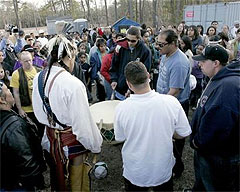MASHPEE RECOGNITION

Chairman Glenn Marshall, on right, and Chief Vernon Lopez announce the news. Photo © AP.

Tribal members and friends celebrate at Mashpee headquarters. Photo © AP
|
With its successful federal recognition decision on Friday, the Mashpee Wampanoag Tribe of Massachusetts avoided pitfalls that hindered several other New England tribes.
In the past six years, seven New England tribal groups have received federal recognition decisions from the Bureau of Indian Affairs. Whether positive or negative, the rulings often focused on the involvement of state governments in Massachusetts and Connecticut, who set aside land or reservations for the tribes and treated them in a distinct fashion.
The Mashpee, in many respects, are no different. Dating back to the first contact with the Mayflower in 1621, the historical record is filled with colonial and state references to the tribe, who were considered wards of the government as early as 1788.
But the BIA's proposed finding doesn't rely on this 300-year-plus state relationship to make the case for federal recognition. Due to evidence of "considerable self-government" since the late 1600s, the Mashpee avoided having to depend on the state's oversight to win a favorable decision.
That sets the Mashpee apart from three Connecticut tribes -- the Eastern Pequot, the Paucatuck Eastern Pequot and the Schaghticoke -- who were denied recognition because they were unable, according to the BIA, to demonstrate continuous community or political influence without relying on state evidence. The Eastern Pequots and the Schaghticoke are now suing in federal court
to overturn their negative decisions.
In all four cases, the Massachusetts and Connecticut tribes had no trouble proving they satisfied the community or political influence tests during colonial times. For the Mashpee, the BIA said they were able to show they were self-governing as far back as 1670, when they organized into "praying towns"
"Within the praying town, the Mashpee governed themselves, without the full rights of Englishmen, and held shared title to the land," the proposed finding states.
During the 1700s, the governments in Massachusetts and Connecticut appointed overseers for their tribes. But the Mashpee continued to show "retained" self-governance despite state involvement starting in 1788, the BIA said.
"During the next 45 years, the Mashpee retained considerable self-government, despite the overseers' presence," the proposed finding states. "In 1834, the state, acting in response to petitions and acts of civil disobedience from the Mashpee, made the town of Mashpee a self-governing 'Indian' district."
Staring in the 1800s, the record starts to diverge for the Mashpee and the Connecticut tribes. During this century, both state governments began to relinquish control over the tribes in an attempt at assimilation. In Connecticut, the state went so far as to terminate some tribes. The tribes in both states lost considerable parts of their land base.
In Massachusetts, the state granted full citizenship to the Mashpee and incorporated their Indian district into a town. But the Mashpee continued to meet the community or political influence tests while the Eastern Pequots and the Schaghticoke had trouble doing so without relying on state evidence, according to the BIA.
For example, the Mashpee "dominated the town government for the next 100 years" after incorporation in 1870. In contrast, the Eastern Pequots and the Schaghticoke weren't able to demonstrate community or political influence, starting in the late 1870s and continuing into the early 1900s, at least in the eyes of the BIA.
The Mashpee were the majority population in their town and controlled the town government up until the 1970s, when the non-Indian population boomed. But the Mashpee retained community or political influence by incorporating a separate tribal council to provide services for tribal members.
In contrast, the BIA said the councils formed by the Eastern Pequots and the Schaghticokes in the 1960s and 1970s did not represent a continuity of self-governance. The decisions for both tribes highlighted the lack of evidence, independent of the state relationship, to patch up holes in the record.
For the Mashpee, the proposed finding is confirmation of their status as a legitimate tribe. "We have always believed that the truth of our petition would be recognized, although it has been a long and hard struggle," said Glenn Marshall, the tribal chairman, on Friday after receiving a phone call from the BIA.
"This decision will ensure that our unique history, culture, and language will not die, and that the men and women who make up this tribe will have the economic tools necessary to remain in our ancestral home," he said.
With no expected opposition to the decision, the tribe is on its way to a final determination by March 2007. The BIA will accept comments for 210 days before the process is complete and the tribe can be added to the list of federally recognized entities.
"Our ancestors, as a sovereign nation, met the Mayflower, and that meeting led to the birth of this great nation," said Vernon Lopez, the tribe's traditional chief. "Today, our government has reaffirmed this status and the faith of that first meeting."
BIA Decision
Summary under the Criteria for the
Proposed Finding
on the
Mashpee Wampanoag Indian Tribal Council, Inc. (March 31, 2006)
Relevant Documents:
Summary of
Acknowledgment Cases |
R. Lee Fleming
Declaration
Only on Indianz.Com:
Federal
Recognition Database V2.0 (May 2005)
Relevant Links:
Mashpee Wampanoag Tribe -
http://mashpeewampanoagtribe.com


